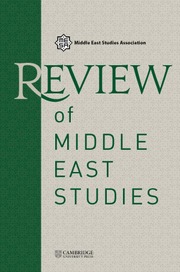No CrossRef data available.
Article contents
Constitutional Reform in Syria: More of the Same
Published online by Cambridge University Press: 25 August 2025
Abstract
In the wake of the 2011 Arab Spring and subsequent revolution, Syria found itself in a rapidly changing environment. The fragility of the state and its constitutional contract led to disintegration into a period of civil violence that has yet to fully resolve. The historical process leading to the Syrian constitution of 1973 sheds some light on the legal and political values encompassed within the constitution and the relationship between the national and international politics of law. Although the current constitution of 2012 offered changes and adjustments, it did not pave the way for any change to the former legacy. A full resolution of Syria’s conflict will require not just a new constitutional text but also an inclusive constitutional process. Years after conflict erupted in Syria, the Baʿth Party had not experienced absolute demise, and the new 2012 constitution had not lead to a free election offering a safe transition. Although the constitution did succeed in eradicating explicit mention of the Baʿth Party, this was never reflected in a practical victory. The country remained a conflict-divided state with a constitution that disappointed expectations. This remained the case until 8 December 2024, with the sudden collapse of the regime that Syrians had longed for. This resulted in an interim government that suspended the constitution and ushered in a new era of de facto crisis with an as yet unclear constitutional legacy.
Information
- Type
- Special Focus Roundtable: Constitutional Change and the Rule of Law
- Information
- Copyright
- © The Author(s), 2025. Published by Cambridge University Press on behalf of Middle East Studies Association of North America
References
1 Nathan J. Brown, “Constitutional Reform in the Arab Spring: A New Beginning or an Unhappy Ending?” Yale Law School Legal Scholarship Repository, 2013, https://openyls.law.yale.edu/bitstream/handle/20.500.13051/17669/Nathan_Brown.pdf%3Fsequence%3D2%26isAllowed%3Dy.
2 Brown, Nathan J., Constitutions in a Nonconstitutional World: Arab Basic Laws and the Prospects for Accountable Government (State University of New York Press, 2002).CrossRefGoogle Scholar
3 Khoury, Philip S., Syria and the French Mandate: The Politics of the Arab Nationalism 1920–1945, Princeton Studies on the Near East (Princeton University Press, 1987).Google Scholar
4 Hadad, Dina, “Human Rights in Syria: The Never-Ending Emergency,” International Journal of Middle East Studies 41, no. 4 (2009).CrossRefGoogle Scholar
5 Kienle, Eberhard, “The Return of Politics? Scenarios for Syria’s Second Infitah,” in Contemporary Syria: Liberalization between Cold War and Cold Peace, ed. Kienle, Eberhard, 114–18 (British Academic Press, 1996)Google Scholar; Seale, Patrick, Asad: The Struggle for the Middle East (University of California Press, 1992)Google Scholar; Carré, Olivier and Seurat, Michel, Les Frères Musulmans 1928–1982 (Gallimard, 1983).Google Scholar
6 1962 Law of Emergency, Legislative Decree No. 51.
7 Hadad, Dina, “Human Rights in the Arab World: A Regional Legacy in Crisis,” Athens Journal of Law 5, no. 3 (2019).CrossRefGoogle Scholar
8 Brown, “Constitutional Reform.”
9 Agamben, Giorgio, State of Exception, trans. Attell, Kevin (University of Chicago Press, 2005)Google Scholar. See also Paye, Jean-Claude, Global War on Liberty (Telos Press, 2007).Google Scholar
10 Schmitt, Carl, Political Theology: Four Chapters on the Concept of Sovereignty (University of Chicago Press, 1922).Google Scholar
11 United Nations Security Council Resolution 2254, 18 December 2015, http://unscr.com/en/resolutions/2254.
12 United Nations, Office of the Special Envoy of the Secretary-General for Syria, “Constitutional Committee,” 2019, https://specialenvoysyria.unmissions.org/constitutional-committee-0.


